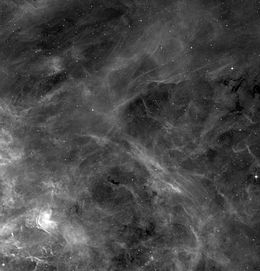BI 253
BI 253| 관찰 데이터 Epoch J2000 Equinox J2000 | |
|---|---|
| 콘스텔레이션 | 도라도 |
| 적경 | 05h 37m 34.461s[1] |
| 적위 | - 69° 01°10.20°[1] |
| 겉보기 등급(V) | 13.76[2] |
| 특성. | |
| 진화 단계 | 주계열[3] |
| 스펙트럼형 | O2V-II(n*)(f)[3] |
| U-B 색지수 | - 1.02[4] |
| B-V 색지수 | - 0.13[4] |
| 아스트로메트리 | |
| 고유운동(μ) | RA: 2[1].3 mas/년 Dec.: 3.1 mas[1]/년 |
| 거리 | 164,000 ly (50,000[5]pc) |
| 절대 등급(MV) | −5.7[3] |
| 상세[6] | |
| 덩어리 | 97.6 M☉ |
| 반지름 | 13.9 R☉ |
| 광도 | 1,175,000 L☉ |
| 표면 중력(log g) | 4.02gs |
| 온도 | 54,000K |
| 회전 속도(v sin i) | 185 km/s |
| 나이 | 0.4+0.8 ~0.4 미르 |
| 기타 명칭 | |
| 데이터베이스 참조 | |
| 심바디 | 데이터. |
BI 253은 대마젤란 구름에 있는 O2V 별이며 O2 유형의 주요 표준입니다.그것은 알려진 가장 뜨거운 주계열성 중 하나이며 가장 크고 밝은 별 중 하나이다.
검출
BI 253은 1975년 대마젤란성운에서 [4]O형 및 B형일 가능성이 있는 272개 별 중 253번째 별로 처음 등재되었다.1995년 스펙트럼 유형은 [7]당시 정의된 가장 이른 O3 V로 분석됐다.
2002년 최초의 O형 별 분류가 개선되었을 때 스펙트럼에 중성 헬륨이 전혀 없거나 이중 이온화된 질소선이 없어 BI 253이 새로운 O2 V 등급으로 분류되었다.헬륨과 [8]질소의 방출선이 매우 약하기 때문에 (f*) 수식자가 주어졌습니다.가장 최근에 발표된 데이터는 O2V-II(n)(f*)의 스펙트럼 유형을 제공하지만, 이것이 더 높은 품질의 스펙트럼 때문인지 아니면 스펙트럼의 [3][9]실제 변화 때문인지는 불분명하다.
BI 253은 황새치자리 [10][11]30의 주성형성 영역 바깥에 비교적 고립된 위치와 높은 우주 속도 때문에 도망성으로 확인되었습니다.약 100만 [12]년 전에 R136 성단에서 방출되었을 가능성이 있습니다.
특성.
BI 253은 가장 뜨겁고 질량이 크며 가장 밝은 주계열성 [13]중 하나입니다.온도는 약 54,000 K이고, 광도는 100만 K가 넘습니다.L, 그리고 질량은 거의 100 입니다☉.M단, 반지름은 14 미만입니다☉.R약 185 km/s의 회전 속도는 높지만, 이는 항성 형성 중 회전하거나 근접 쌍성계의 합성으로 인해 가장 젊고 뜨거운 별에서 흔히 볼 수 있다☉.
진화
BI 253은 중심핵에서 여전히 수소를 연소시키고 있지만 강한 회전과 대류 혼합과 강한 항성풍으로 인해 표면에서 질소와 헬륨이 풍부하게 축적되어 있음을 보여준다.85에서 예상되는 ZAMS 위치에 매우 근접합니다.M ☉ BI 253보다 질량이 큰 별은 주계열에서도 [13]거대 또는 초거대 광도 등급을 나타낼 것으로 예상된다.
레퍼런스
- ^ a b c d Zacharias, N.; Urban, S. E.; Zacharias, M. I.; Wycoff, G. L.; Hall, D. M.; Germain, M. E.; Holdenried, E. R.; Winter, L. (2003). "VizieR Online Data Catalog: The Second U.S. Naval Observatory CCD Astrograph Catalog (UCAC2)". CDS/ADC Collection of Electronic Catalogues. 1289. Bibcode:2003yCat.1289....0Z.
- ^ Rivero González, J. G.; Puls, J.; Najarro, F.; Brott, I. (2012). "Nitrogen line spectroscopy of O-stars. II. Surface nitrogen abundances for O-stars in the Large Magellanic Cloud". Astronomy & Astrophysics. 537: A79. arXiv:1110.5148. Bibcode:2012A&A...537A..79R. doi:10.1051/0004-6361/201117790. S2CID 119110554.
- ^ a b c d Bestenlehner, J. M.; Gräfener, G.; Vink, J. S.; Najarro, F.; De Koter, A.; Sana, H.; Evans, C. J.; Crowther, P. A.; Hénault-Brunet, V.; Herrero, A.; Langer, N.; Schneider, F. R. N.; Simón-Díaz, S.; Taylor, W. D.; Walborn, N. R. (2014). "The VLT-FLAMES Tarantula Survey. XVII. Physical and wind properties of massive stars at the top of the main sequence". Astronomy & Astrophysics. 570: A38. arXiv:1407.1837. Bibcode:2014A&A...570A..38B. doi:10.1051/0004-6361/201423643. S2CID 118606369.
- ^ a b c Brunet, J. P.; Imbert, M.; Martin, N.; Mianes, P.; Prévot, L.; Rebeirot, E.; Rousseau, J. (1975). "Studies of the LMC stellar content. I. A catalogue of 272 new O-B2 stars". Astronomy and Astrophysics. 21: 109. Bibcode:1975A&AS...21..109B.
- ^ Evans, C. J.; Taylor, W. D.; Hénault-Brunet, V.; Sana, H.; De Koter, A.; Simón-Díaz, S.; Carraro, G.; Bagnoli, T.; Bastian, N.; Bestenlehner, J. M.; Bonanos, A. Z.; Bressert, E.; Brott, I.; Campbell, M. A.; Cantiello, M.; Clark, J. S.; Costa, E.; Crowther, P. A.; De Mink, S. E.; Doran, E.; Dufton, P. L.; Dunstall, P. R.; Friedrich, K.; Garcia, M.; Gieles, M.; Gräfener, G.; Herrero, A.; Howarth, I. D.; Izzard, R. G.; et al. (2011). "The VLT-FLAMES Tarantula Survey. I. Introduction and observational overview". Astronomy & Astrophysics. 530: A108. arXiv:1103.5386. Bibcode:2011A&A...530A.108E. doi:10.1051/0004-6361/201116782. S2CID 54501763.
- ^ Schneider, F. R. N.; Sana, H.; Evans, C. J.; Bestenlehner, J. M.; Castro, N.; Fossati, L.; Gräfener, G.; Langer, N.; Ramírez-Agudelo, O. H.; Sabín-Sanjulián, C.; Simón-Díaz, S.; Tramper, F.; Crowther, P. A.; De Koter, A.; De Mink, S. E.; Dufton, P. L.; Garcia, M.; Gieles, M.; Hénault-Brunet, V.; Herrero, A.; Izzard, R. G.; Kalari, V.; Lennon, D. J.; Maíz Apellániz, J.; Markova, N.; Najarro, F.; Podsiadlowski, Ph.; Puls, J.; Taylor, W. D.; et al. (2018). "An excess of massive stars in the local 30 Doradus starburst". Science. 359 (6371): 69–71. arXiv:1801.03107. Bibcode:2018Sci...359...69S. doi:10.1126/science.aan0106. PMID 29302009. S2CID 206658504.
- ^ Massey, Philip; Lang, Cornelia C.; Degioia-Eastwood, Kathleen; Garmany, Catharine D. (1995). "Massive stars in the field and associations of the magellanic clouds: The upper mass limit, the initial mass function, and a critical test of main-sequence stellar evolutionary theory". Astrophysical Journal. 438: 188. Bibcode:1995ApJ...438..188M. doi:10.1086/175064.
- ^ Walborn, Nolan R.; Howarth, Ian D.; Lennon, Daniel J.; Massey, Philip; Oey, M. S.; Moffat, Anthony F. J.; Skalkowski, Gwen; Morrell, Nidia I.; Drissen, Laurent; Parker, Joel Wm. (2002). "A New Spectral Classification System for the Earliest O Stars: Definition of Type O2". The Astronomical Journal. 123 (5): 2754. Bibcode:2002AJ....123.2754W. doi:10.1086/339831.
- ^ Walborn, N. R.; Sana, H.; Simón-Díaz, S.; Maíz Apellániz, J.; Taylor, W. D.; Evans, C. J.; Markova, N.; Lennon, D. J.; De Koter, A. (2014). "The VLT-FLAMES Tarantula Survey. XIV. The O-type stellar content of 30 Doradus". Astronomy & Astrophysics. 564: A40. arXiv:1402.6969. Bibcode:2014A&A...564A..40W. doi:10.1051/0004-6361/201323082. S2CID 119302111.
- ^ Gvaramadze, V. V.; Kroupa, P.; Pflamm-Altenburg, J. (2010). "Massive runaway stars in the Large Magellanic Cloud". Astronomy and Astrophysics. 519: A33. arXiv:1006.0225. Bibcode:2010A&A...519A..33G. doi:10.1051/0004-6361/201014871. S2CID 118579026.
- ^ Evans, C. J.; Walborn, N. R.; Crowther, P. A.; Hénault-Brunet, V.; Massa, D.; Taylor, W. D.; Howarth, I. D.; Sana, H.; Lennon, D. J.; Van Loon, J. Th. (2010). "A Massive Runaway Star from 30 Doradus". The Astrophysical Journal Letters. 715 (2): L74. arXiv:1004.5402. Bibcode:2010ApJ...715L..74E. doi:10.1088/2041-8205/715/2/L74. S2CID 118498849.
- ^ Lennon, D. J.; Evans, C. J.; Van Der Marel, R. P.; Anderson, J.; Platais, I.; Herrero, A.; De Mink, S. E.; Sana, H.; Sabbi, E.; Bedin, L. R.; Crowther, P. A.; Langer, N.; Ramos Lerate, M.; Del Pino, A.; Renzo, M.; Simón-Díaz, S.; Schneider, F. R. N. (2018). "Gaia DR2 reveals a very massive runaway star ejected from R136". Astronomy and Astrophysics. 619: A78. arXiv:1805.08277. Bibcode:2018A&A...619A..78L. doi:10.1051/0004-6361/201833465. S2CID 59058322.
- ^ a b Doran, Emile I.; Crowther, Paul A. (2011). "A VLT/UVES spectroscopy study of O2 stars in the LMC". Société Royale des Sciences de Liège. 80: 129. Bibcode:2011BSRSL..80..129D.



